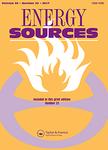版权所有:内蒙古大学图书馆 技术提供:维普资讯• 智图
内蒙古自治区呼和浩特市赛罕区大学西街235号 邮编: 010021

作者机构:Islamic Azad Univ Dept Mech Engn Dezful Branch Dezful Iran Katholieke Univ Leuven Dept Civil Engn Bldg Phys & Sustainable Design Sect Leuven Belgium Sharif Univ Technol Dept Energy Engn Tehran Iran
出 版 物:《ENERGY SOURCES PART A-RECOVERY UTILIZATION AND ENVIRONMENTAL EFFECTS》 (Energy Sources Recovery Util. Environ. Eff.)
年 卷 期:2021年第47卷第1期
页 面:10047-10063页
核心收录:
学科分类:0820[工学-石油与天然气工程] 0830[工学-环境科学与工程(可授工学、理学、农学学位)] 0817[工学-化学工程与技术] 08[工学] 0807[工学-动力工程及工程热物理]
主 题:Exergy exergoeconomic optimization thermoelectric heat pump evolutionary algorithms response surface method
摘 要:In this study, modeling of an irreversible thermoelectric heat pump was conducted, and its performance was assessed in terms of exergy for 10, 20, 30 and 40 K difference in temperature ( increment T) by changing the values of the design parameters. By employing this model, positive impact of increasing cross-section area, current and thermocouple s length which in turn increases the exergy efficiency is realized. In addition, diminishing adverse impact of adding more thermocouples on the exergy efficiency of the system is illustrated. Afterward, exergoeconomic performance of the thermoelectric heat pump is evaluated. Then, exergoeconomic factor for each of the system s components is diagnosed. The value of the mentioned parameter for the whole system is 60.6%, representing the ratio of the investment costs to exergy destruction costs. Considering the two objectives of reducing the unit cost of produced heat and increasing the exergy efficiency, the thermoelectric heat pump was optimized to create a temperature difference ( increment T) of 30 K by state of the art optimization algorithms such as MOPSO, SPEA2, PESA2 and response surface method (RSM). Comparing the drawn Pareto of each algorithm reveals that the Pareto drawn by the SPEA2 algorithm had better quality than the other two algorithms. Utilizing SPEA2 algorithm for this study yielded an exergoeconomic factor of 0.5 $/kWh and 14.8%, while the results obtained via evolutionary algorithms in this experiment are optimal compared to the RSM.